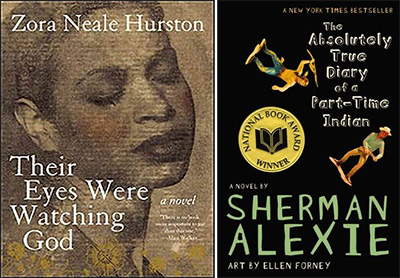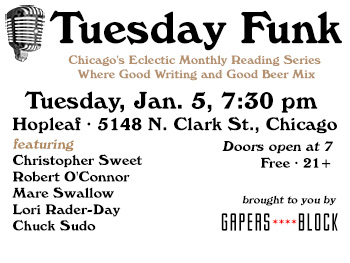| « Bookmarks! | Bookmarks! » |
Education Wed May 27 2015
Chicago Schools Make Moves to Include Women, Minorities on Required Reading Lists
 By Samantha English & Barbara Cruz
By Samantha English & Barbara Cruz
When you think of the books that are read and taught in high schools across the country, what are the first titles that come to mind? The Great Gatsby, Lord of the Flies, The Catcher in the Rye and Of Mice and Men probably flood your memory. The authors of these books — F. Scott Fitzgerald, William Golding, J.D. Salinger and John Steinbeck, respectively — have something in common: They're all white men.
The truth is, many assigned reading lists are short on female and minority authors. But some schools are making strides to change that. Because the literary canon taught in today's schools is often the groundwork for post-secondary education, critics believe a predominately white male perspective could have negative effects on students.
Some argue that teaching the canon to students who no longer find relevance in the issues presented will fail to stimulate teens and ultimately turn them away from reading.
"When we think about summer reading books or adding a new book to a course, we're often looking for women or people of color," said Scott Campbell, an English teacher at New Trier High School, who admitted there's a gap in the curriculum where minority writers should be.
He also said he believes this void stems from systematic oppression.
"Women a hundred or so years ago were not encouraged or expected that they might write, so we're left with literature that seems unbalanced and institutionalized, almost in the way we talk about racism," Campbell explained.
He called it the "Virginia Woolf problem," which the famous 20th century author depicted in her essay A Room of One's Own. The essay's narrator argues that because women aren't treated as equals, they're unable to produce the same caliber of work as men.
"Women haven't been championed as writers generally," Campbell said. "This is just one of the after-effects of male domination."
Some students said they've noticed the void but that schools aren't always to blame, citing bigger societal issues.
"I think yes, book lists in schools are sexist, but I don't think it's the schools' fault," said Jones senior Sarah Eiden. "I think it's because we still think good literature is only written by white males, which simply isn't true. I do see though that teachers are trying to change that."
Natalie Garfield, an English teacher and curriculum coordinator at John Hancock College Prep, said she's trying to shake things up at her school. Hancock teachers make an effort to deviate from the canon when appropriate, something that has changed only recently.
Through her experience at various schools, Garfield said she's found that some of the most common titles read by high school students are from authors like Steinbeck and William Shakespeare.
But Hancock's curricula include books and concepts teachers believe to be more culturally relevant to their students. Themes have included power and justice, humanity and social responsibility and decisions, actions and consequences, which are taught through The Kite Runner, Fahrenheit 451 and The Absolutely True Diary of a Part-Time Indian, respectively.
"At the end of their high school career, a kid can pick up any new book and potentially have been exposed to anything like it based on the wide spectrum of texts that we offer here," Garfield explained. "[You] make changes and reflect the times and kids in front of you."
Still, some students warn that there's a fine line between a culturally relevant curriculum and one that's trying too hard.
"We come from a Hispanic culture, but even when they give us 'Hispanic books,' it's more like, just Hispanic people trying to fit into a white community," said Hancock senior Lisseth Perez. "It's the same book over and over: Hispanic kid wants to go into the white community and not get looked down upon."
Hancock junior Sandra Rodriguez said she's appreciative of her school's inclusive selections that replace some of the traditional high school reads.
"These books just talk about men and men and men. And they never actually show women actually doing something," she said. "You have to read something you feel good about."
~*~
You don't have to banish the classics, but why not read something different this summer? These books showcase diversity and the importance of equality through gripping, emotional, must-read narratives.
When I Was Puerto Rican
By Esmeralda Santiago
As the first of three autobiographical books by Puerto Rican native Esmeralda Santiago, "When I Was Puerto Rican" describes the author's early life punctuated by extreme poverty and familial strife. After her brother Raymond is injured in a bike accident, Santiago's mom decides to uproot her family and move to New York City to seek medical care and a better life. There, Santiago and her family encounter racism as they move through the unfamiliar city landscape. She has a way of telling her story that can only be described as gripping. You won't be able to stop reading her words, so pick up the other two installments, Almost a Woman and The Turkish Lover, before you start.
The Bluest Eye
By Toni Morrison
"The Bluest Eye" is perhaps one of the most important books of the last half-century. Both heartbreaking and intimate, Toni Morrison paints a picture of a town marred by racism and poverty and demonstrates how mixing the two can cause irreparable damages. This novel follows the struggles of Pecola Breedlove, a young girl living in Lorain, Ohio, who finds herself losing her mind over the tragedies that have affected her and her family. Morrison writes in such a poetic way that the emotions jump off the page. Though themes of racism and sexual abuse make this a tough read at times, it's an absolute must for modern bookworms.
The Woman Warrior: Memoirs of a Girlhood Among Ghosts
By Maxine Hong Kingston
Published in 1976, this work of creative nonfiction weaves together five short stories to create Maxine Hong Kingston's autobiography. Using several perspectives and traditional Chinese folklore, Kingston explains what it means to be a woman in her family and culture. Not only is it an amazing depiction of Chinese customs and their clash with American society, but the book also shows how stories of the past can affect individuals far into the future. This unique, groundbreaking read walks the line of fiction and nonfiction, magic and reality.
 Their Eyes Were Watching God
Their Eyes Were Watching God
By Zora Neale Hurston
Sometimes the history of a novel is just as important as the story itself. Their Eyes Were Watching God, the tale of a woman searching for love, was initially disregarded when it was first published in 1937. However, the book is now considered a classic. Hurston's work was rediscovered in the 1970s by Alice Walker, author of The Color Purple. Hailed for its revival story and depiction of black women, Their Eyes Were Watching God follows Janie Crawford through three very different marriages and stages of her life. Though it was once forgotten, no student should miss this book.
Always Running: La Vida Loca, Gang Days in L.A.
By Luis J. Rodriguez
Always Running is an autobiography that's difficult to get through. Luis J. Rodriguez tells his no-holds-barred story and refuses to censor the devastation that took over his life. The plotline explores gang violence, unemployment, expulsion, drug addiction, incarceration and suicidal thoughts. But in the end, it's a positive, uplifting story of a man who realizes his potential as a Chicano activist and artist and manages to turn his life around. This book gives readers a raw look at what it meant to be Latino in Los Angeles during the '80s and how community involvement can truly impact marginalized groups.
The Absolutely True Diary of a Part-Time Indian
By Sherman Alexie
Compared to the other titles on this list, The Absolutely True Diary of a Part-Time Indian is on the modern end of the spectrum. Sherman Alexie wrote the fictional tale about Junior, a 14-year-old Native American teen who lives on a reservation and attends a predominately white high school. Ellen Forney's original illustrations make it a fun, humorous read. Though it's a somewhat controversial book (some schools have even banned it), Alexie is raw and honest about topics like alcoholism, sexuality, violence and bullying.
The Handmaid's Tale
By Margaret Atwood
Set in the not-so-distant future, Margaret Atwood creates a dystopian world where women are incredibly controlled and separated into strict classes. Handmaid Offred tells readers the story of her life, before and after the alteration of her country. This incredibly important piece of feminist literature is the perfect companion to George Orwell's Nineteen Eighty-Four, a popular choice among English teachers. Readers can almost feel the chill of absolute control described on the pages of this book. It brings a true understanding to the importance of equality.
In the Time of the Butterflies
By Julia Alvarez
Set in the Dominican Republic, the historical novel In the Time of the Butterflies follows the lives of the Mirabal sisters and their family as they live under the oppressive Rafael Trujillo dictatorship in the 1950s and '60s. The book is packed with true accounts and narrated by the four sisters (Minerva, Maria Teresa, Dede and Patria) as they live their lives as young women and political activists. They document the struggles of adhering to the standards of both in this emotional read.
This article was written by Samantha English of William Jones College Preparatory High School and Barbara Cruz of John Hancock College Preparatory High School, and was originally published at TheMash.com on May 21, 2015. It is featured here as part of our new content exchange program with TheMash, the Chicago Tribune's teen edition.









